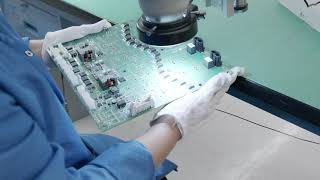LED PCB boards have unique specifications, especially for containing spillover light and for managing heat dissipation from LEDs. A PCB fabricator must completely adhere to the specifications to make a success of the project. At PCB Trace Technologies Inc., we have the necessary technology to make high quality LED PCBs and assemblies.
Spillover Light
When operating, LEDs transmit the maximum amount of light from the top. However, they also transmit a small amount of light from the side and rear, and this is spillover light. Usually, this spillover light is not useful, unless you use a white solder mask on the PCB that acts as a reflector to send the light back to the front. However, some white solder masks change color when heated such as during the reflow process. Their thickness decreases, and they grow dull under heat during reflow, no longer fully reflecting the spillover light from the LED.
PCB Trace Technologies Inc uses a special solder mask that does not discolor or become dull under heat, and does not grow thin. We use Taiyo’s LEW1 as solder mask, as it does not change color under the intense heat from the reflow process, rather maintaining its brilliance.
Heat Management
Although LEDs are high-efficiency devices, they do dissipate a small amount of heat. For high-power LEDs, the heat they generate can be substantial, and the PCB must use an effective strategy for heat management to prevent the LEDs from failing.
PCB Trace Technologies Inc. uses metal core printed circuit boards (MCPCBs) that help in effectively dissipating the heat generated by the LEDs mounted on LED PCB boards. We use metal core substrates from Univace, Arton, Bergquist, or Thermagon. The metal core these substrates use adequately removes the heat that the LEDs generate. However, the heat from the LEDs must travel through the prepreg first before it can reach the metal core, and this often poses a challenge.
The thickness of the prepreg and its bonding to the metal core is crucial to the heat flow. PCB Trace Technologies Inc. uses a thin prepreg for effective heat transfer. However, the prepreg is adequately thick to act as an insulator between copper traces on the PCB and the metal core.
The bonding process of the prepreg to the metal core is also very important. The process PCB Trace Technologies Inc. uses does not allow the presence of insulating air bubbles between the metal core and the prepreg. As air is a bad conductor of heat, the presence of air bubbles can reduce or impede the heat flow.
For more information about our LED PCB boards and assemblies, contact PCB Trace Technologies Inc. over phone or send us an email. We have been fabricating PCBs for many decades, and we have the expertise and know-how for assisting you with LED PCB boards and assemblies, and their design.





